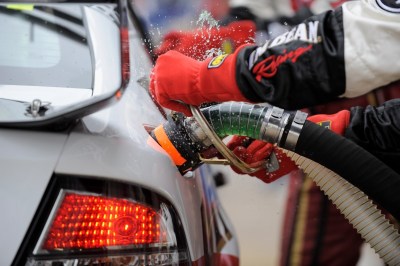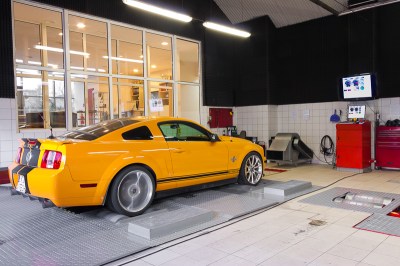How To Get Into Cars: E85 Fuel

If you’ve spent any time around the modified car scene in the last few years, you’ve probably heard about E85. Maybe you’ve even noticed a sweet smell emanating from the pitlane, or heard people cracking jokes about “corn juice.”
The blended fuel, which combines alcohol and traditional gasoline, can have significant performance benefits if used properly. Today, we’ll explore what those are, and how you can set your ride up to run on E85.
Pros and Cons
E85 is, nominally at least, a blend of 85% ethanol with 15% gasoline. In some countries, this is adhered to fairly religiously. However, in the United States, E85 that you get at the pump can be anywhere from 51% ethanol to 83%, with lower blends typically being delivered in cooler areas and during winter. This is due to the poorer cold start performance of ethanol-based fuels. However, if you’re buying drums of race-grade E85, you’re likely getting something much closer to that nominal ratio.

The main benefits of E85 fuel are simple and straightforward. Ethanol has a far higher octane rating than regular gasoline. Where the standard stuff comes in around 87, and premium pump gas gets up to 93, E85 fuel has an octane rating closer to 103-105 octane as per the (R+M)/2 measurement used in the USA.
Octane rating is important when it comes to knock resistance. Knock occurs when the fuel-air charge detonates instad of burning smoothly. Otto-cycle engines (i.e. gas engines) can be tuned to make more power by advancing the timing of the ignition spark, setting the fuel aflame as the piston is rising on the compression stroke. However, advance the timing too far, and burn the fuel-air charge too soon, and pressures in the cylinder can get too high, causing the fuel to detonate instead of burn in a more controlled manner. This can damage an engine very quickly.
Just as premium gas is more knock resistant than regular gas, E85 is even more knock resistant again. This allows an engine to be tuned with more ignition timing advance, as well as more boost in the case of forced-induction engines. Thus, it’s possible to tune an engine to make more power with E85 without experiencing damage from knock.

E85 also has a higher latent heat of vaporization than straight gasoline, meaning that as the fuel is injected into the engine, it absorbs more heat from the intake air. The cooler charge produces more power.
However, it’s not all win when it comes to running E85. E85 contains roughly 27% less energy per gallon than gasoline. This means that fuel economy is typically worse when running E85, in the vicinity of 20-30% worse in a properly-tuned vehicle. So to make the same power on E85, an engine must flow more fuel compared to gasoline. If you’re looking for a boost, flow rates go up even further.
The fuel is also hygroscopic, meaning it absorbs water from the atmosphere. This can give E85 a poor shelf life, as fuel that carries excess water content doesn’t perform as well. Worries about corrosion are typically overblown, but the fuel can have issues in some older fuel tanks, particularly those of composite materials. Older cars, typically from the 80s and before, may also have rubber fuel system components that degrade in the presence of ethanol, clogging fuel filters and injectors. However, cars from the late 90s onwards are typically all protected against this; hence the mainstream use of E10 gas across the world.
How To Reap The Benefits
So, you’ve read all about how E85 can give your engine more power, and you’re keen to take advantage. Great! However, unless you’re driving a car already tuned for flex fuel use, you’ll likely need to make some modifications. However, as hackers, that’s what we’re all about, so prepare to dive in.

The first thing your engine will need is a tune. If your car has a locked-down engine management system from the factory, you’ll likely need to go ahead and replace it entirely with a standalone tuneable ECU. Alternatively, some cars have tuneable ECUs from the factory if you have the right tools. Either way, you’ll need to be able to control spark timing and your fuel map to get the most out of E85.
Advancing the timing, and adding boost in forced induction applications, is how you unlock more power, while the fuel map must be tuned to account for the changes and make up for the lower energy value of E85. Dyno tuning is best, as it allows outside variables to be controlled, but the truly adventurous and experienced could always try a road tune instead.
You’ll also likely want to run a flex-fuel sensor so your ECU can deal with varying ethanol levels in the fuel. E85 pumps aren’t everywhere, and few of us fully drain our tanks when refilling them. Gas stations selling blends anywhere from 51 to 83% ethanol only adds to the confusion. If you pour in a 51% ethanol on top of a half-tank of straight gas, your functional octane level would be that of E25, somewhere in the mid-90s. If your tune expects an octane level of over 100, you’ll quickly get knock. A flex fuel sensor lets your car be tuned for straight gas and E85, and then interpolates depending on the detected ethanol level in the fuel lines.
Alternatively, if you’re running a car with a vintage ignition and carby setup, you’ll need to run some alcohol-safe fuel lines, twist the distributor for a bit more advance, and change the jets to flow more fuel. You may also want to get an E85 kit for your carb to ensure that old gaskets and seals don’t react with the ethanol. Alternatively, carbs designed to run E85 from the outset exist, designed specifically to handle the higher fuel flow required. However, there’s no easy way to do flex fuel with a carby setup, so if you tune for E85, don’t expect the car to run well or at all on regular gas anymore.

Beyond this, you may find your fuel system needs some modifications too. That 30% less energy density means your engine needs a lot more fuel than it did before, and if your fuel pump didn’t have a lot of headroom, then it could be quickly tapped out on E85. Thus, a bigger fuel pump is often key to switching over to run on E85. Similarly, if you’re finding your injectors are tapped out at 100% duty cycle and still aren’t flowing enough fuel, you may need to upgrade those to higher-flow units as well.
With all that done, you should have a car that’s happily running on E85. In naturally-aspirated applications, gains of around 5-10% are typical. It’s not a huge figure, but it can be useful in combination with other things like high-compression pistons, or it can help a highly-stressed race engine to run a little cooler.
However, with forced induction, E85 comes into its own. Its knock-prevention capabilities typically allow turbo and supercharged engines to run much more boost without incurring detonation. This extra air can then be mixed with more fuel for yet more power. A great example is the Koenigsegg CCX, which produced 806 horsepower on premium gasoline, while its sibling, the CCXR, put out 1018 horsepower, a full 25% more, running on E85.
Summary
If you’ve got a modern fuel-injected car, and a tuneable ECU, you could find switching to E85 one of the best bang-for-your-buck performance mods out there. However, if your car is one that needs major fuel system upgrades or a new engine management system to make the change, the value proposition might not stack up as well. Regardless, E85 is a great performance fuel, and there are gains to be had. If you decide to start running your car on corn sauce, we wish you good luck, and happy hacking!
Post a Comment